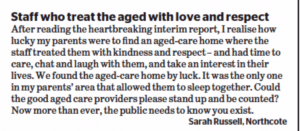29 April 2019
Our democracy depends on the robust contest of policies. Yet so far the federal election campaign has been dominated by personal insults, pork barrelling and heated discussions about preference deals. I’ve hardly heard a whisper from candidates about their party’s aged care policies.
I am standing as a candidate for Reason Australia in my local electorate (Cooper in inner city Melbourne) so I can put aged care in the election spotlight. Reason brings an evidence-based approach to all its policies, including aged care policies.
Aged care needs evidence-based, not opinion-based, policies. It also needs kindness. Rather than listen to the opinions of the usual suspects who are part of the broken system that has failed older Australians, we need new thinking. To quote Albert Einstein: “We cannot solve our problems with the same thinking we used when we created them”.
Reason Australia’s policies “Respecting older people” are:
- Implement strategies to combat ageism
- Establish a national framework of Healthy Ageing
- Support the aged care diversity framework and action plans to ensure equality in care for elder Australians
- Create age and dementia friendly environments within communities
- Re-write the Aged Care Act 1997 from a human rights perspective
- Transparency about how aged care providers spend government subsidies
- Mandatory reporting of elder abuse
ALP and Greens also released new policies on ageing and aged care. The Liberal Party has not announced any new aged care election policies. Perhaps they consider their track record speaks for itself.
Consistent with LNP’s focus on the ‘top end of town’, the government recently gave $320 million to aged care providers without any obligation that this money will improve services for older people. The Reason Party disagrees with giving providers a one off cash injection without any strings attached. Taxpayers’ moneyshould be used to improve the quality of life of older people not the pockets of providers.
The numerous aged care inquiries, reviews, consultations, think-tanks and task forces over the past decade have resulted in a large number of recommendations. Both LNP and ALP governments have ignored most of these recommendations. In fact, the 2013 aged care reforms that have marketised residential and in-home aged care have bipartisan support. This may explain why ALP is not talking about aged care.
The Greens’ policies on aged care are much more progressive than either mainstream party. The Greens are the only political party to address the low salaries of aged care workers. They also support staff ratios in aged care homes though curiously their policy does not require a registered nurse to be on site 24 hours per day. When there is no registered nurse on site, elderly residents, particularly those who are uncommunicative, do not receive timely treatment when their condition changes. In some cases, this is a form of neglect.
The Greens’ policies include the government spending a further $8.5 billion – $3 billion on aged care homes and $5.5 billion on home care packages. They sensibly include a cap on the percentage of the funding given to service providers that can be used for administration rather than direct resident care.
Although more staff, better pay and releasing more home care packages are important, we do not support the government giving more money to aged care providers until providers are transparent about how they spend this money. There must be transparency about how aged care providers spend government subsidies.
Both the ALP and Greens have policies to address elder abuse. The ALP policy states: “Labor will address the prevalence of elder abuse”. The Greens’ policy on elder abuse is slightly stronger, but not strong enough. The Greens state: “Measures to prevent and respond to elder abuse”. In contrast, Reason’s policy makes it mandatory to report elder abuse.
According to the Aged Care Act (1997), providers must “maintain an adequate number of appropriately skilled staff to ensure that the care needs of care recipients are met”. Although 51 ALP candidates support staff ratios in aged care homes, the ALP policy on staffing in aged care homes states: “adequate staffing levels with the appropriate mix of skills”. The ALP policy does not rock the boat.
Reason not only rocks the boat, we tip the boat over. Our policy is a game changer. We don’t tinker with The Act (e.g. mandate ratios), our policy is to re-write the Act from scratch.
Reason Australia envisages an Aged Care Act that focuses on the human rights of older Australians not the profits of providers. This new Aged Care Act will include transparency about staffing levels/training and data about quality indicators. Every aged care home will be required to publish data on quality indicators such as pressure sores, medication errors, weight loss, falls, infection rates admissions to hospitals. They will also need to disclose complaints and how these complaints were resolved. Finally, the new Aged Care Act will require the registration of all workers.
Reason Australia recognises that current policies on ageing and aged care are underpinned by ageism. To achieve justice for older people, we have inclusive policies to combat ageism, homophobia and racism. Our policies also focus on healthy ageing and age and dementia friendly environments within our communities. If older people choose to live in their own home, a retirement village or an aged care home, they deserve respect, kindness and love.
